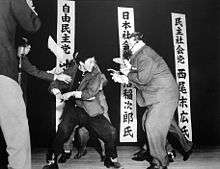Otoya Yamaguchi
| Otoya Yamaguchi | |
|---|---|
 | |
| Native name | 山口 二矢 |
| Born |
February 22, 1943 Tokyo, Japan |
| Died |
November 2, 1960 (aged 17) Japan |
| Known for | Assassination of Inejiro Asanuma |
Otoya Yamaguchi (山口 二矢 Yamaguchi Otoya, February 22, 1943 – November 2, 1960) was a Japanese ultranationalist who assassinated Inejiro Asanuma, a politician and head of the Japan Socialist Party. Yamaguchi was a member of a right-wing Uyoku dantai group, and assassinated Asanuma by yoroidōshi on October 12, 1960, at Tokyo's Hibiya Hall during a political debate in advance of parliamentary elections.[2]
Death
Less than three weeks after the assassination, while being held in a juvenile detention facility, Yamaguchi mixed a small amount of toothpaste with water and wrote on his cell wall, "Seven lives for my country. Long live His Imperial Majesty, the Emperor!" Yamaguchi then knotted strips of his bedsheet into a makeshift rope and used it to hang himself from a light fixture.[3] The phrase "seven lives for my country" was a reference to the last words of 14th-century samurai Kusunoki Masashige.
Legacy
A photograph taken by Yasushi Nagao immediately after Otoya withdrew his sword from Asanuma would later go on to win the 1961 Pulitzer Prize,[1] and the 1960 World Press Photo award. Footage of the incident was also captured.[4]
Nobel Prize-winning author Kenzaburō Ōe based his 1961 novellas Seventeen and The Death of a Political Youth on Yamaguchi.[5]
References
- 1 2 Zelizer, Barbie (2010). About to Die:How News Images Move the Public. Oxford: Oxford University Press. pp. 183–4. ISBN 0199752133. Retrieved 2012-08-18.
- ↑ "山口 二矢" [Otoya Yamaguchi]. Nihon Jinmei Daijiten (in Japanese). Tokyo: Shogakukan. 2012. Retrieved 2012-11-07.
- ↑ "Assassin's Apologies". TIME Magazine. November 14, 1960. Retrieved June 11, 2010.
- ↑ Inejiro Asanuma Assassination Footage (1960) (Digital video). YouTube.com (published May 18, 2006). October 12, 1960. Retrieved June 11, 2010.
- ↑ Weston, Mark (1999). Giants of Japan: The Lives of Japan’s Most Influential Men and Women. New York: Kodansha International. p. 295. ISBN 1-568362862.